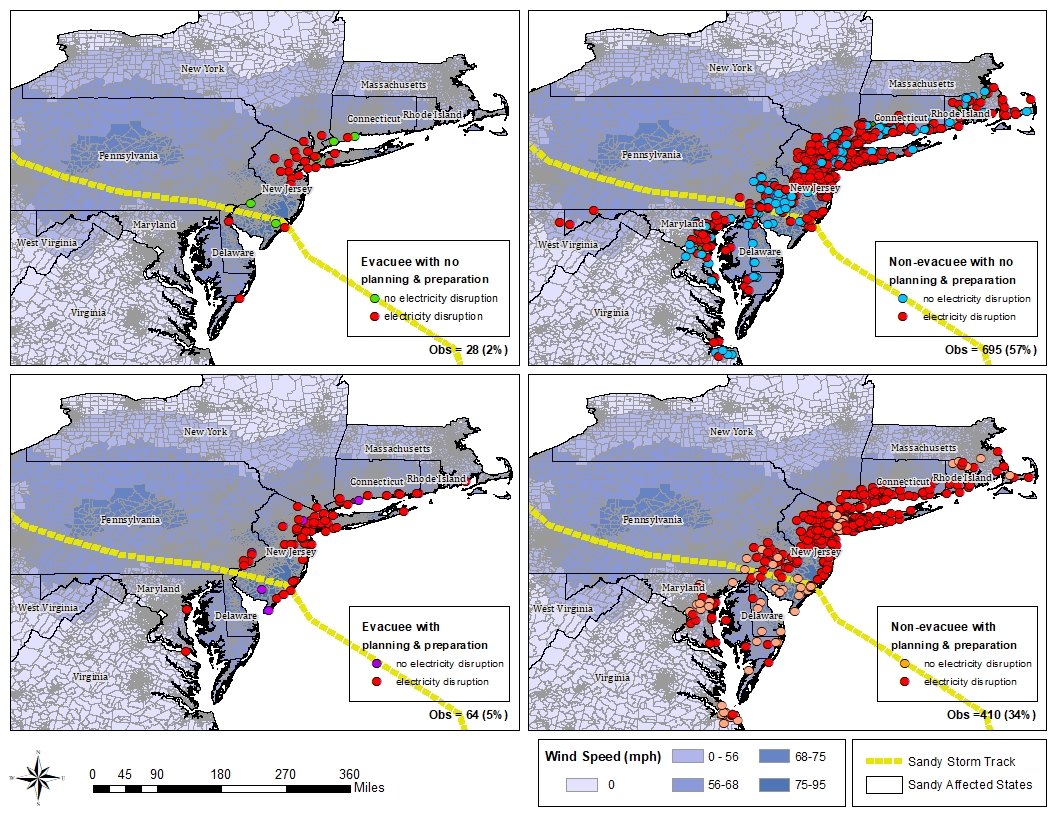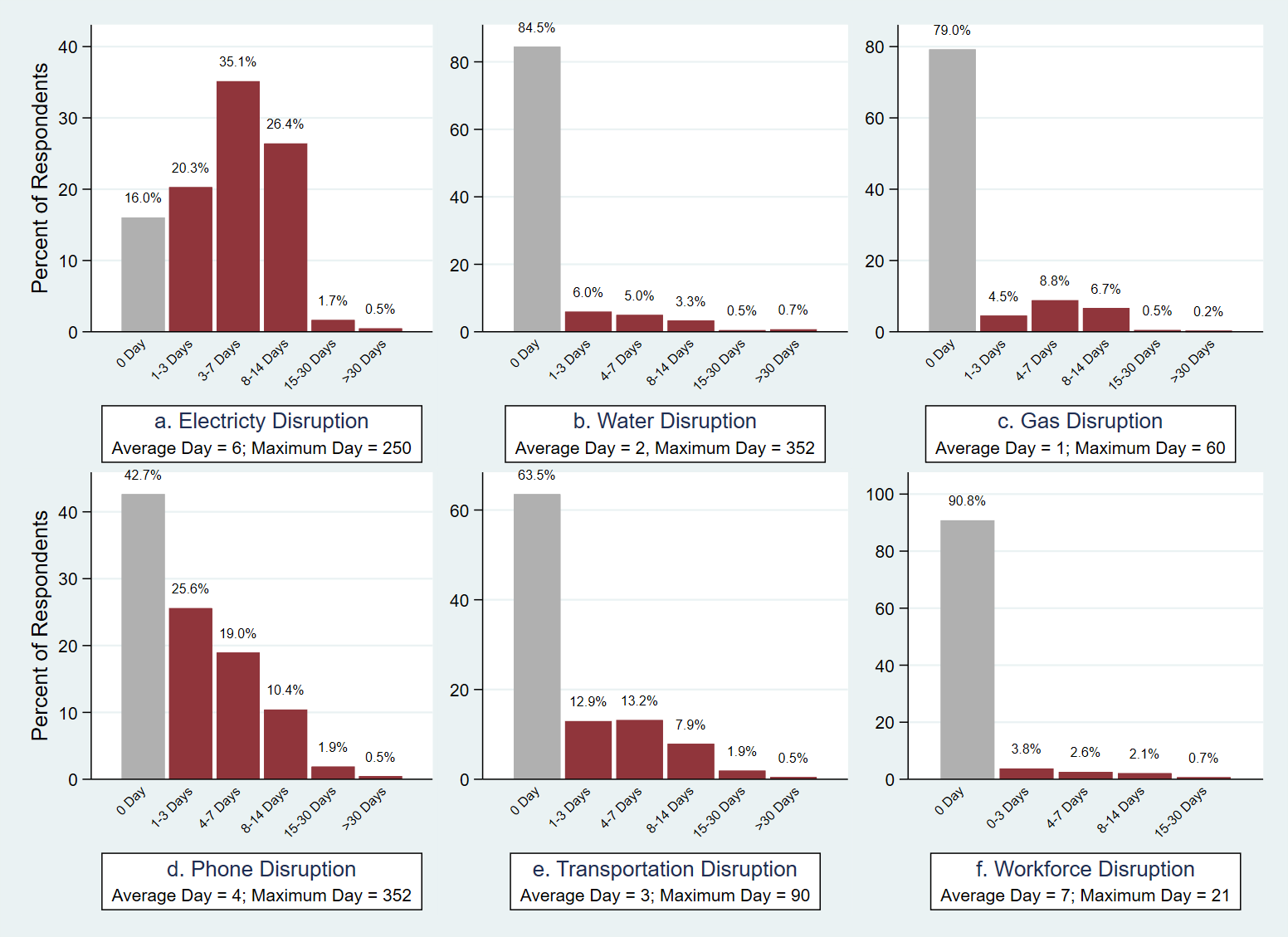Hurricane Sandy: Damages, Disruptions and Pathways to Recovery
Meng, S. & Mozumder, P. (2021) Hurricane Sandy: Damages, Disruptions and Pathways to Recovery. Economics of Disasters and Climate Change, 5:223-247. https://doi.org/10.1007/s41885-021-00082-7

Critical infrastructure and public utility systems are often severely damaged by natural disasters like hurricanes. Based on a framework of household disaster resilience, this paper focuses on the role of utility disruption on household-level recovery in the context of Hurricane Sandy. Using data collected through a two-stage household survey, it first confirms that the sample selection bias is not present, thus the responses can be estimated sequentially. Second, it quantitatively examines factors contributing to hurricane-induced property damages and household-level recovery. The finding suggests that respondents who suffered from a longer period of utility disruptions (e.g., electricity, water, gas, phone/cell phone, public transportation) are more likely to incur monetary losses and have more difficulty in recovering. Effective preparedness activities (e.g., installing window protections, having an electric generator) can have positive results in reducing adverse shocks. Respondents with past hurricane experiences and higher educational attainments are found to be more resilient compared to others. Finally, the paper discusses the implications of the findings on effective preparation and mitigation strategies for future disasters.
Keywords Household recovery; Utility disruption; Hurricane sandy; Hurricane preparation
Evacuation Planning and Preparation for Future Hurricanes: Role of Utility Service Disruptions
Halim, N., Jiang, F., Khan, M., Meng, S. & Mozumder, P. (2021) Household Evacuation Planning and Preparation for Future Hurricanes: Role of Utility Service Disruptions. Transportation Research Record, 2675(10): 1000-1011. https://doi.org/10.1177%2F03611981211014529

We analyzed data from a survey administered to 1,212 respondents living in superstorm Hurricane Sandy-affected areas. We estimated the effect of having experienced hurricane-induced disruptions to utility services, such as electricity, water, gas, phone service, and public transportation, on having an evacuation plan. Around 39% of respondents reported having an evacuation plan in case a hurricane affects their neighborhood this year. Respondents who had experienced disruptions to electricity supply had an approximately 11 percentage-point higher likelihood of having an evacuation plan than those who had experienced no such disruptions. Respondents who had experienced monetary losses from Hurricane Sandy had around a five percentage-point higher likelihood of having an evacuation plan compared with those who had not. Among control variables, prior evacuation, distance to the coastline, residence in a flood zone, concern about the impacts of future natural disaster events, had window protection, and household members being disabled, each had an association with residents’ future evacuation planning and hurricane preparedness. In light of these findings, we discuss the policy implications of our findings for improving disaster management in hurricane-prone areas.
Integrating Household Survey with Inoperability Input-Output Model of Critical Infrastructure Systems: A Case Study of Hurricane Sandy
 Santos, J., Meng, S. & Mozumder, P. (2024) Integrating Household Survey with Inoperability Input-Output Model of Critical Infrastructure Systems: A Case Study of Hurricane Sandy. Risk Analysis, 44: 1716–1729. https://doi.org/10.1111/risa.14257
Santos, J., Meng, S. & Mozumder, P. (2024) Integrating Household Survey with Inoperability Input-Output Model of Critical Infrastructure Systems: A Case Study of Hurricane Sandy. Risk Analysis, 44: 1716–1729. https://doi.org/10.1111/risa.14257
Critical infrastructures are ubiquitous and their interdependencies have become more complex leading to their uncertain behaviors in the aftermath of disasters. The article develops an integrated economic input–output model that incorporates household-level survey data from Hurricane Sandy, which made its landfall in 2012. In this survey, 427 respondents who were living in the state of New Jersey during Hurricane Sandy were used in the study. The integration of their responses allowed us to show the probability and duration of various types of critical infrastructure failures due to a catastrophic hurricane event and estimate the economic losses across different sectors. The percentage of disruption and recovery period for various infrastructure systems were extracted from the survey, which were then utilized in the economic input–output model comprising of 71 economic sectors. Sectors were then ranked according to: (i) inoperability, the percentage in which a sector is disrupted relative to its ideal level, and (ii) economic loss, the monetary worth of business interruption caused by the disaster. With the combined infrastructure disruptions in the state of New Jersey, the model estimated an economic loss of $36 billion, which is consistent with published estimates. Results from this article can provide insights for future disaster preparedness and resilience planning.
Keywords critical infrastructure systems, disaster resilience, economic input–output model, household survey, inoperability modeling
Related Study: Rafi, S., Meng, S., Santos, J. & Mozumder, P. (2024) Extreme Weather Events and the Performance of Critical Utility Infrastructures: A Case Study of Hurricane Harvey. Economics of Disasters and Climate Change, 8: 33-60. https://doi.org/10.1007/s41885-023-00139-9